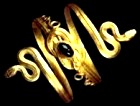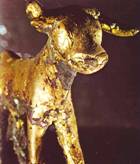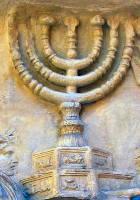Jewels in the ancient world
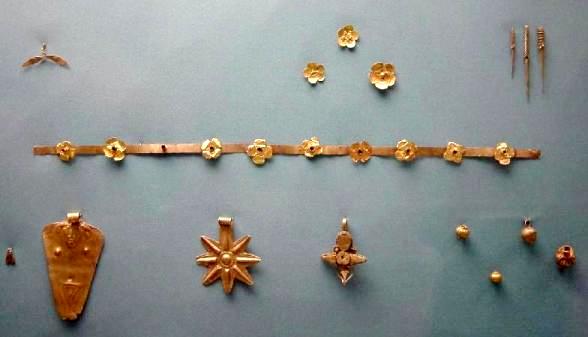
Miscellaneous Canaanite jewelry excavated at Tel-al-Ajjul
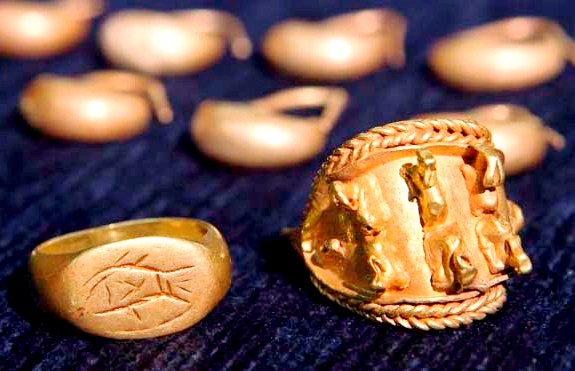
Stop press
Archaeologists have just unearthed a hidden stash of gold jewelry (above) near the site of the ancient city of Armageddon, where the New Testament says the final battle between good and evil will take place.
The jewelry was found inside a clay pot as if it had been hidden from an enemy, perhaps during a siege. The owner of the jewelry never came back to claim it….

Why have jewels? Silly question…
Jewels are beautiful. We value them for their color and sparkle. But they are also
- portable wealth.
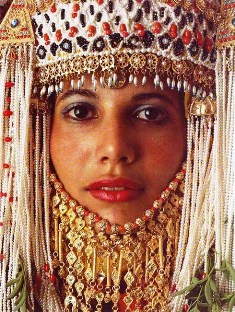
- an in-your-face status symbol, letting everyone know how rich you are.
That is why young women in the ancient world of the Bible draped themselves in their dowry jewelry on their wedding day. In a not-very-subtle way they were telling their new husband and his family that they were women of substance, not to be lightly treated.
See Money and Marriage for Bible Brides
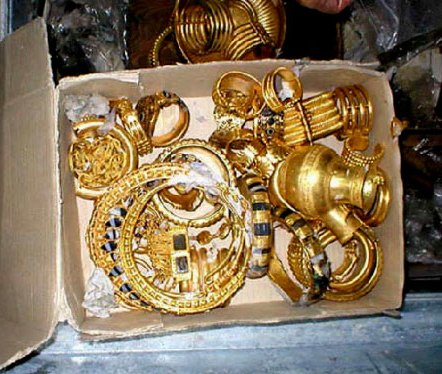
A treasure-trove of ancient jewels from the tomb at Nimrud (see information below)
How did ancient jewels survive?
 Look at the gold necklace at right. It belonged to a queen in the ancient Assyrian city of Nimrud. Most people would like to own it.
Look at the gold necklace at right. It belonged to a queen in the ancient Assyrian city of Nimrud. Most people would like to own it.
And that is the secret of jewels:
- their beauty and rarity makes them objects of desire
- being desirable makes them valuable
- and being valuable makes them perfect for showing off.
Women have always used jewelry to show off their status and wealth, and enhance their own beauty. Even the Cro-Magnons 40,000 years ago had primitive necklaces and bracelets.
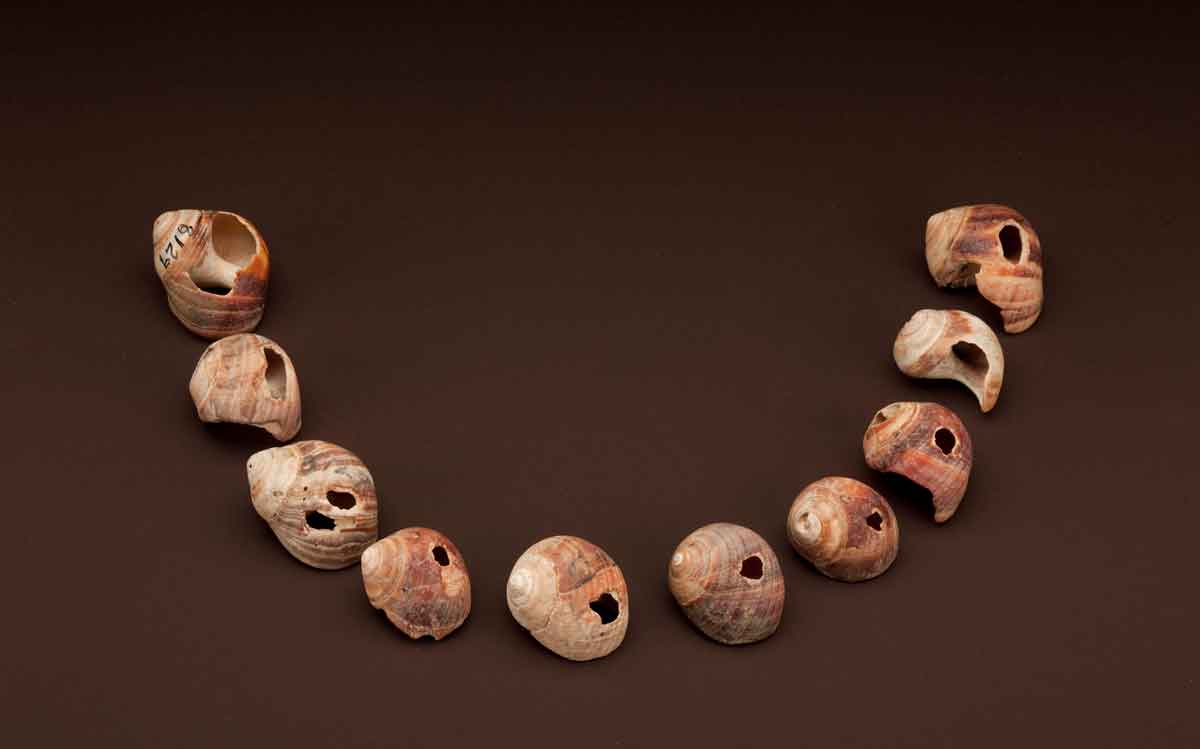
Cro-Magnon shell-beads
But one way or another, almost all the jewelry from ancient times was destroyed.
A few pieces survived in hiding places, put there long ago for safe-keeping during wars and invasions. These precious pieces were left untouched for thousands of years, because the people who knew where the treasure was hidden were slaughtered or taken captive, never to return. The secret of the jewelry’s location died with them.
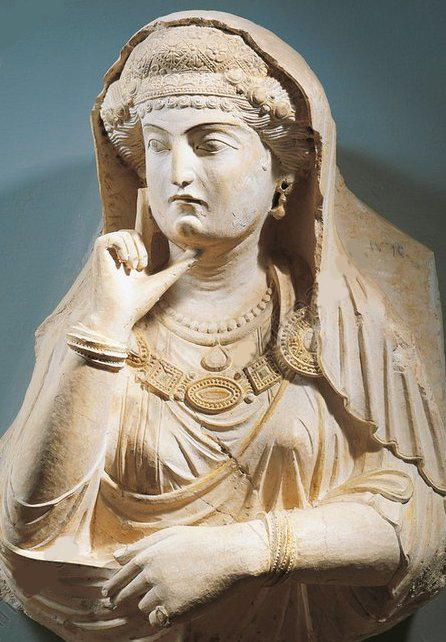
Woman with jewels, statue from
Palmyra’s Valley of the Tombs
Other jewels survived because of some natural disaster, such as the volcanic eruption at Pompeii (see the gold bracelet below, which was found alongside a body at Pompeii). People trying to flee the cataclysm snatched up any portable valuables they could carry, then found they had left their escape too late.
The valuables, often pieces of jewelry, lay hidden and forgotten for many centuries.

Bracelet found at Pompeii, 1st century AD
What jewelry did Bible people wear?
We have very little to go on, but we know that the Jewish people borrowed craftsmen from surrounding countries like Phoenicia. These men produced designs similar to the ones they made in their native countries, so it is fair to assume that Jewish women wore jewelry similar in design to Egyptian, Mesopotamian and Assyrian pieces.

Jewelry, Egyptian, 22nd dynasty. During this dynasty, Shoshenq I invaded the kingdom of Judah and Israel, and overran Jerusalem and nearby cities in about 925 BCE. He took the Temple and palace treasures, including the golden shields of Solomon, back to Egypt.
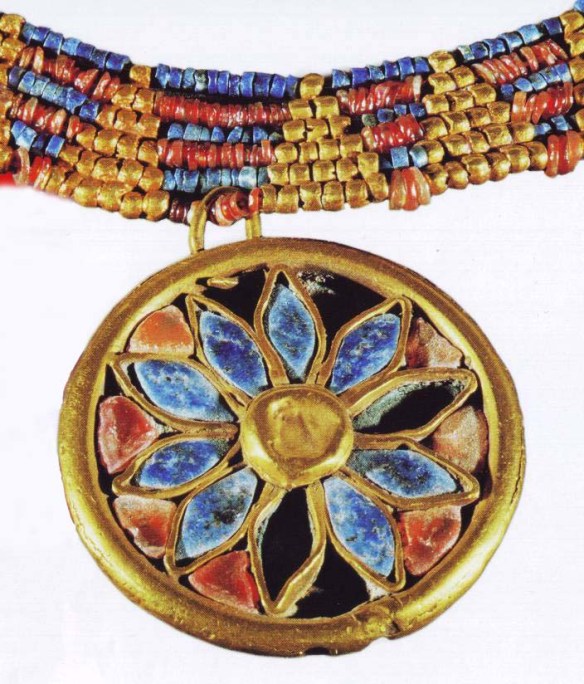
Necklace with inlaid lapis lazuli and carnelian gemstones,
Iraz Museum, Baghdad

Part of a diadem found in a tomb at Ur
During the later Greek and Roman periods, the upper classes in Israel were besotted with foreign fashions and design. Jewish women wore jewels similar to pieces worn in ancient Greece and Rome.

Gold diadem embellished with blue, green, red, and white enameled flowers; from a tomb at Canossa, 3rd century BC
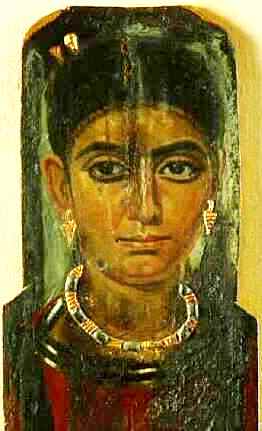
A woman with her jewels, from the Fayum coffin portraits, 2-3rd century AD Egypt
Links with the Bible
During the reign of Solomon’s son Rehoboam, Judah was overrun by the Egyptian ruler Shoshank I. Rehoboam was forced to pay a huge ransom to get rid of him, including not only the Temple treasures, but the jewelry belonging to the royal women of Judah. This jewelry was probably taken back to Egypt to be melted down and re-used, and then after that, who knows?

Ancient Egyptian bracelet or gold and semi-precious stones
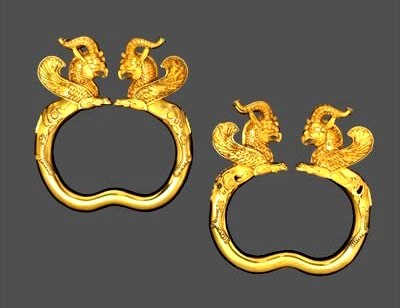
Ancient Persian bracelets/clasps
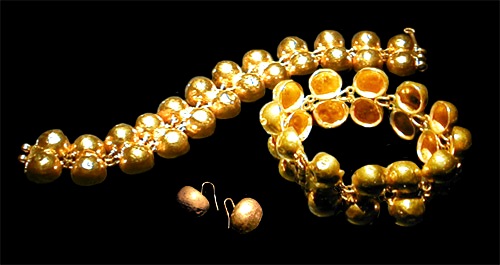
Gold bracelet and earrings from Pompeii
‘The Assyrian came down like a wolf on the fold, and his cohorts were gleaming with purple and gold….’. King Sargon II of Assyria (721–705BC) is famous for his conquest of Israel. He took the ten tribes of Israel, the Lost Tribes, into captivity (2 Kings 17:6). See Nimrud Jewelry.

The woman on this ivory plaque wears an Egyptian-style wig and an elaborate ornament with pendants in her hair.
The image fits the description of Jezebel in 2 Kings 9:30-37.
The woman at the window with her head adorned (above), is a frequent motif in the ancient near-Eastern world. The Bible’s favorite villainess Jezebel is described like this immediately before her death (2 Kings 9:30-37).
For Bible references to ancient jewelry, see also
- Genesis 24:53: ‘And the servant brought out jewelry of silver and of gold, and garments, and gave them to Rebekah…’
- Exodus 32:24: ‘So I said to them, ‘whoever has gold, take it off’; so they gave it to me, and I threw it into the fire, and out came this calf!’
- Exodus 35:22: ‘So they came, both men and women; all who were of a willing heart brought brooches and earrings and signet rings and pendants, all sorts of gold objects, everyone bringing an offering of gold to the Lord.’
- Hosea 2:13: ‘I will punish her for the festival days of the Baals, when she offered incense to them and decked herself with her ring and jewelry, and went after her lovers, and forgot me, says the Lord.’

A simple bracelet and necklace from Mesopotamia, original home of Sarah and Abraham
Canaanite ‘horned’ bracelet
A bronze bracelet dating to the Late Bronze Age (ca. 1550–1200 BC) has been found during an excavation at Ramat Razim in the vicinity of Zefat (Tsefat, Safad). Karen Covello-Paran, director of the excavation, says,
“We discovered a wide rare bracelet made of bronze. The ancient bracelet, which is extraordinarily well preserved, is decorated with engravings and the top of it is adorned with a horned structure.
At that time horns were the symbol of the storm-god and they represented power, fertility and law. The person who could afford such a bracelet was apparently very well off financially, and it probably belonged to the village ruler.
It is interesting to note that in the artwork of neighboring lands gods and rulers were depicted wearing horned crowns; however, such a bracelet, and from an archaeological excavation at that, has never been found here.”
Jewelry of Queen Puabi

The flattened skull and jewelry of Queen Puabi just as it was found in her tomb at Ur in Sumeria – where Sarah and Abraham were born. Notice, too, her perfect teeth…
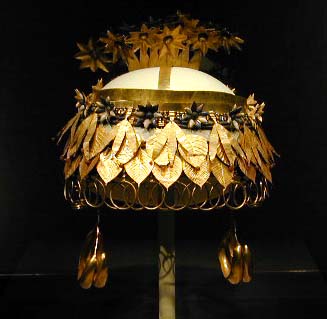
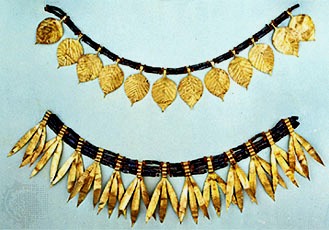
Jewelry taken from Queen Puabi’s tomb at Ur in ancient Sumeria, 3rd millennium BC.
The various pieces could be arranged in several different ways, as necklace or crown

Polished beads from the tomb of Queen Puabi
The Nimrud treasure
‘Last year, exploring an inner room of the palace, a team of laborers (headed by Muzahim Mahmoud Hussein, leader of the Iraqi team at Nimrud) stumbled across a tomb that contained a small collection of necklaces, earrings and gilded pins. In April, Muzahim found what looked like a piece of pavement. When he and his workers cleared off the dirt, they uncovered a small ceramic pipe resembling an air vent.
The “pavement” turned out to be the arched roof of a small rectangular tomb. Inside was a dusty sarcophagus. “I pried the top off with an iron bar,” says Muzahim. “There was more dust inside, but when I held up the light, it was reflected back into my eyes by the gold.”
Much of that gold turned out to be priceless jewelry draped around the skeleton of a young princess named Yabahya, tentatively identified as the daughter of one of Assyria’s most renowned and feared kings, Sargon II.
Nearby, still more jewelry and gold ornaments were piled.
Mingled with the dried bones were dozens of delicately sculpted gold rosettes, scattered like flowers over the body of the dead princess.’ (Quoted from Time magazine article, Philip Elmer-Dewitt, October 13 1989)
 Nimrud: ugal or headdress worn by the Queen[/caption]
Nimrud: ugal or headdress worn by the Queen[/caption]
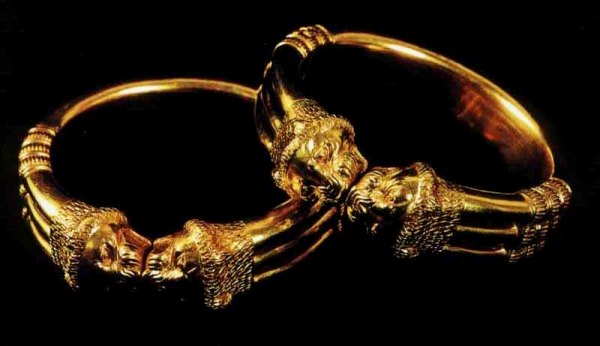
Nimrud: gold bracelets
Jewelry from Troy
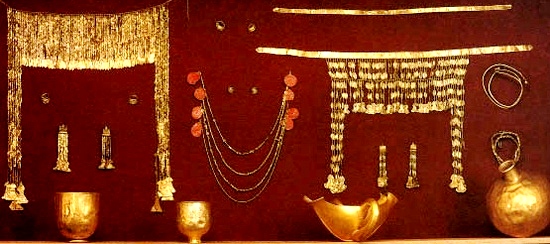
Gold jewelry from Troy II, 3rd millennium BC

Gold pin with filigree work, from ‘Priam’s Treasure’, Troy
Luxury Objects
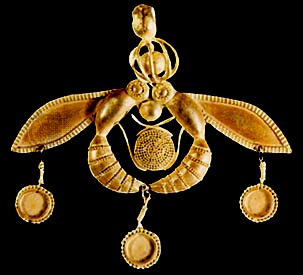
Mycenaean gold pendant, 17thcentury BC
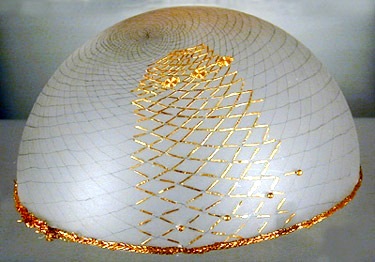
Fragment from a delicate gold hairnet
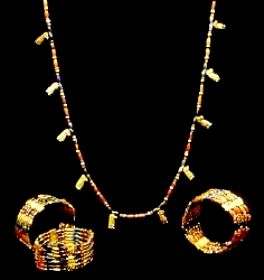
Jewels of a tribal princess like Sarah, circa 1500BC
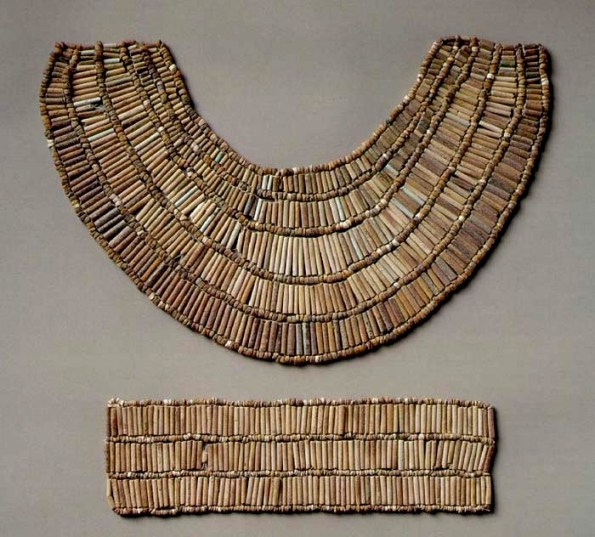
An early piece of Egyptian jewelry from the 5th dynasty: collar and bracelet
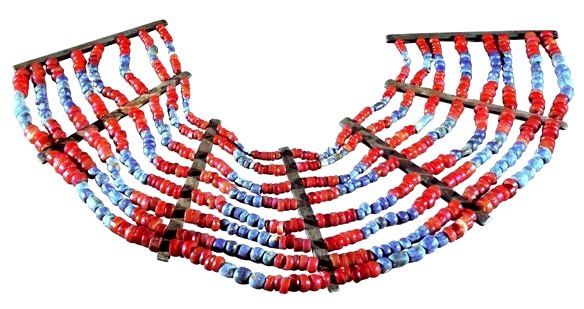
The same basic design as above, but with more expensive stones
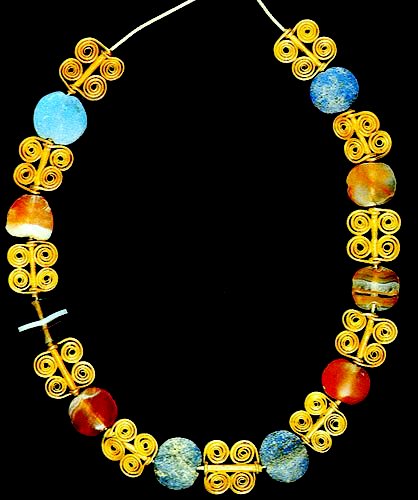
Necklace circa 14-13th century BC, found at Mari, a flourishing city west of the Euphrates
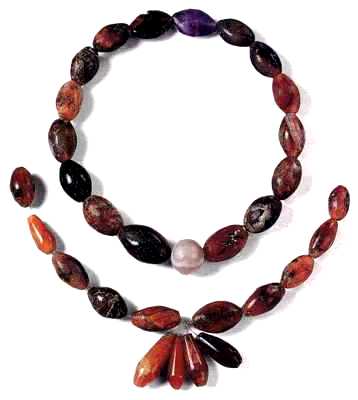
Necklace beads, 13th century BC
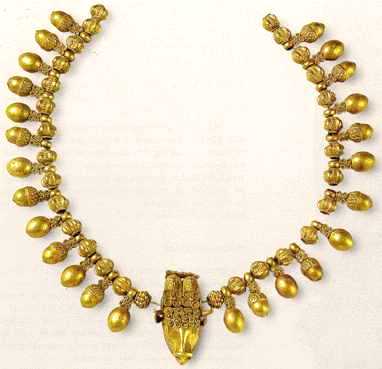
Gold necklace, 5th century BC
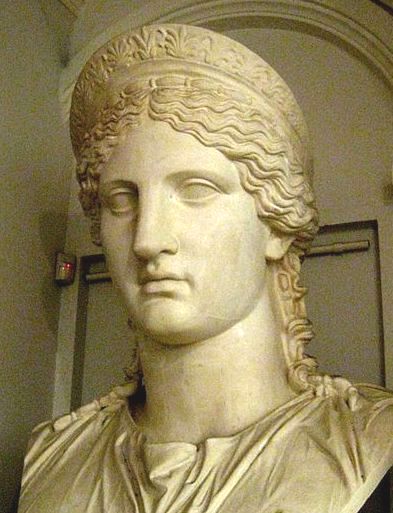
This Roman bust of Antonia Minor shows her wearing a diadem, probably of beaten gold
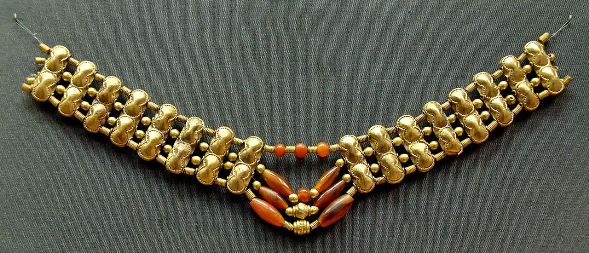
Cornelian necklace, Roman era
See other fascinating links between Archaeology & the Bible
Search Box
![]()
© Copyright 2006
Elizabeth Fletcher




